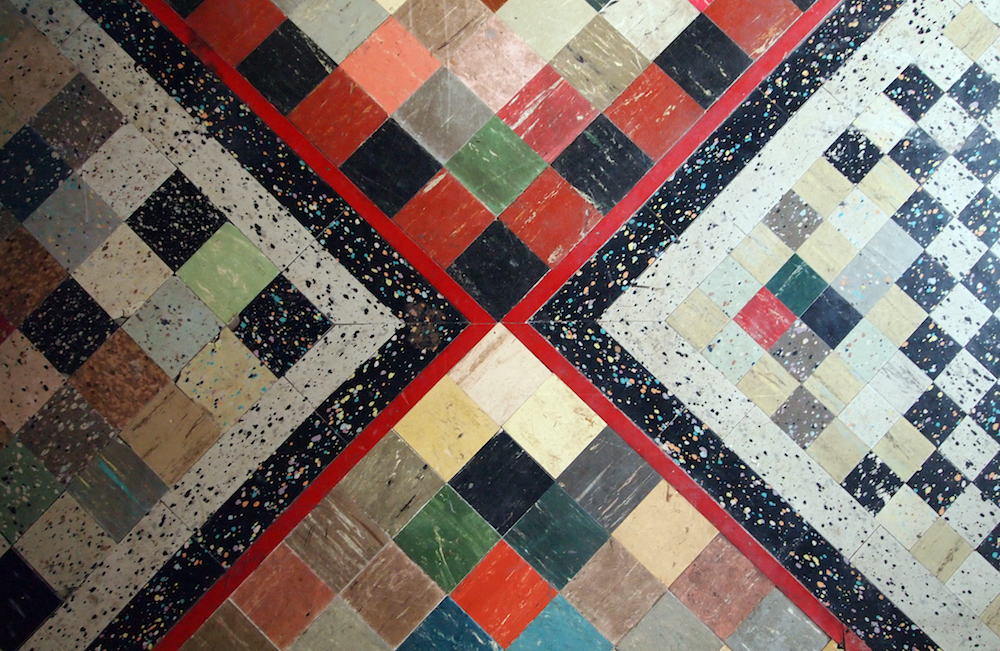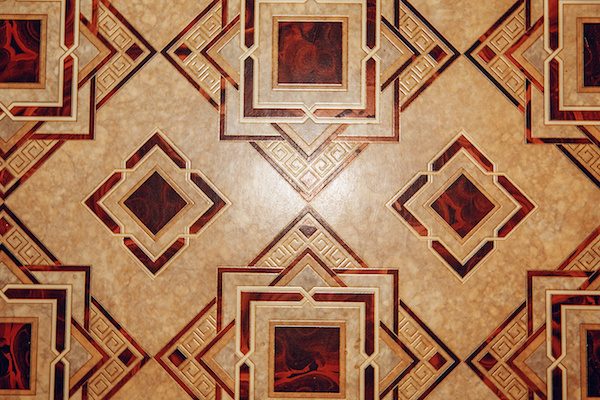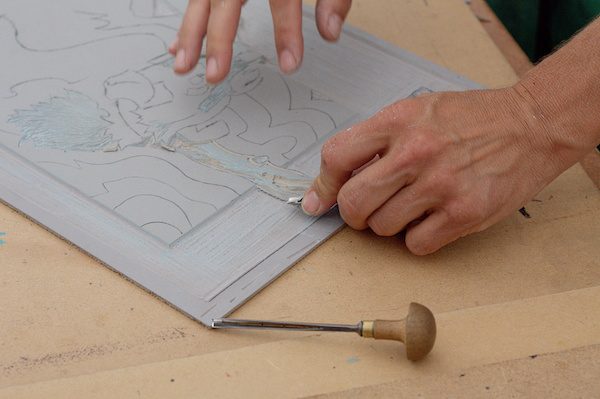
Writer Hattie Jean Hayes shares why linoleum—unlike a summer fling—is “enduring and lasting.” Courtesy of Harold Hollingsworth/Flickr.
Zócalo’s editors are highlighting some of our favorite pieces from the archive. This week, we’re revisiting writer Hattie Jean Hayes’ history of the once-ubiquitous, “softer than metal, less brittle than wood” floor covering: linoleum.
Some things in modern life are so common they become indispensable, inescapable, and, if you have the right attitude, enchanting.
Like linoleum.
On a date in downtown Kansas City, my companion and I found ourselves outside a custom linoleum shop. Having exhausted our life stories and mutual interests, we were in a conversational rut. So I wandered into the store.
I began to rattle off various facts about linoleum, its production, and its uses. While speaking, I realized I had unintentionally memorized the linoleum chapter of Bathroom Stuff, a book my mother had picked up at Big Lots for 99 cents because the rubber duck on the cover matched our bathroom motif. Over five years of idle browsing, I’d somehow learned a whole lot about linoleum. Other people in the store began mistaking me for an employee. So, faced with a growing crowd of curious locals with many questions, I told them—and my visibly startled date—everything I knew.
As I explained then, and have learned in more detail since, linoleum has been a vital part of society for well over a century. It’s enduring and lasting—unlike the fling that brought me into a downtown linoleum shop years ago. And also unlike short-lived summer romances, it isn’t sexy. But linoleum has a rich history in art and industry that you should remember next time you walk across a particularly beautiful patterned floor.
In his workshop one ordinary day, English hairbrush manufacturer Frederick Walton noticed the skin of oil floating on top of a can of paint. It wasn’t anything remarkable, but a spark of ingenuity took hold, and Walton realized the oxidized linseed oil could make a strong waterproofing agent for the brushes he made. Curiosity piqued, Walton began experimenting with various linseed oil compositions in his spare time.
He understood the potential of the substance, but few of its revolutionary applications. However, having good faith in his ability to figure something out, Walton purchased a factory and began manufacturing this oil-putty for use in various industries. By the 1860s, Walton realized his compound wasn’t as stiff as the materials that were popular at the time, which were made from rubber and less-malleable resins. His flexible formula could be poured onto a fabric backing, then rolled flat to make a sort of dropcloth. Its resistance to water and oils quickly lead to Walton’s patent for a durable floor cloth, which Walton christened “linoleum” and patented in 1863.

Linoleum floor with brown geometric pattern. Photo courtesy of Nata Zhekova/Adobe Stock.
The final formulation of linoleum was a slurry of wood flour, ground cork, minerals and pine rosin, mixed into linseed oil and placed on a canvas or burlap backing. Walton standardized a means of interlocking layers of the material for added stability, which would later lead to the aesthetic benefit of creating patterns in the colored surfaces of the linoleum.
The slow growth period paid off and linoleum rapidly became a favored flooring option. And as commercial use increased, more benefits to the material appeared—ones that Walton hadn’t noted in his exploratory production period. Namely, the oil in linoleum was constantly oxidizing. So, over time, it became more durable rather than wearing down, unlike glass or clay tiles that chipped and cracked.
It was ideal for use in kitchens and bathrooms. It was easy-to-clean and had antibacterial properties, again thanks to its unique organic formulation. It was also perfect for use on the Titanic, which boasted intricate black-and-white linoleum patterns on the grand staircase and nautical blue-and-white tiling around the swimming pool.
Though linoleum seems hardly luxurious today, elaborate craftwork on the Titanic made for opulent displays. And linoleum weighed less than glass tiles or marble flooring—though in retrospect, this aspect of linoleum’s utility did not offset other, weaker choices in the ship’s construction.
The aesthetic qualities of linoleum are still admired now, particularly as historic preservation becomes more popular and nostalgia infiltrates our collective consciousness. But the majority of “linoleum” flooring you see in modern homes, that checkered pattern quintessential to retro-style kitchens, is typically vinyl, and not nearly as beautiful as its predecessor.
I saw this firsthand when I moved away from Missouri a few years ago and my younger brother, on the cusp of his unruly teen years, took over my old bedroom. He insisted his “man cave” remodel include marble flooring. This was outside our budget, so instead my mother found vinyl tiles with a marble-inspired pattern. I noted that the company also sold “linoleum-style” flooring—which is to say vinyl.
Vinyl flooring made a grand debut at the Chicago World’s Fair in 1933, and while its durable, space-age nature captured many hearts, it proved hard to produce when World War II put a clamp on resources. Vinyl burst into popularity during the early 1950s. Brighter colors, cleverer patterns, and a cheaper installation cost made vinyl the new favorite for households in the ‘50s and ‘60s. Some companies even replicated popular linoleum patterns in their vinyl sheeting. For the first time in the 20th century, linoleum was on a downswing.

Preparing a linocut design. Photo courtesy of Richard Wheeler/Wikimedia Commons.
Linoleum has endured because its contemporary manufacturers have gotten creative in using it. Blocks of linoleum have become particularly important in art and art schools. Softer than metal, less brittle than wood, and easier on the hands than both, linoleum was the top choice for art students who needed to carve. And while some “serious” artists dismiss the compound as a children’s toy, linoleum is a significant part of art history. One of the pioneers of the linocut printing process was Henri Matisse, who produced a series of elegant linoleum reliefs in the 1930s and ‘40s. These pieces lent themselves to easy reproduction, and helped inspire other artists who favored the starkly graphic nature of the linocuts’ lines. One notable fan was Pablo Picasso, who perfected and then revolutionized the linocut technique.
Picasso devised a new technique that produced staggeringly elaborate works that were nearly impossible to replicate. Beginning with a large, single block of linoleum, Picasso would carve and print the lightest colored layer of the design, then shave it off completely to begin his next layer. The process took lots of thought and careful planning. By the time a piece was finished, the linoleum block would be carved down into a stump—and its vibrant, multicolored print could never be reproduced. Contemporary printing methods have lessened the popularity of linocut production, but the method remains popular among amateurs. And of course, the art of pioneers like Matisse and Picasso continues to influence creative minds today.
Currently, as the existence of linoleum shops in downtown arts districts demonstrate, linoleum is in the midst of another renaissance. Though its popularity as flooring never fully recovered from its late 20th century decline, it is eco-friendly and resilient, improving its status as a flooring option for the sustainability-minded. It also looks prettier than less-sophisticated substitutes, thanks to refined production processes and brighter, longer-lasting natural dyes.
This newest upswing brought linoleum back into my life years after my first encounter with it in the wild. When I worked for a public relations and consulting group, we handled the local promotion for a flooring store’s grand opening. Lo, behold, etc., they carried linoleum and marketed it as an eco-conscious product. I was eager to do new research on a topic that had become a fixation for me, even if it meant my co-workers called me an “odd duck.”
I embraced the insult. If finding excitement in the everyday makes me an odd duck, then put me in a pond and throw me some breadcrumbs, dammit. Doesn’t the purest joy come from finding magic in the mundane?
That’s how Walton found his inspiration for linoleum, anyway—a passing glance at an everyday object. Take a deeper look into the world around you, and you’ll find yourself gazing at the limitless power of the cosmos. Indulge your simple curiosities, and you can allow yourself to be re-enchanted by the world. And barring all that, as my first date with a summer fling revealed, active learning makes you interesting.
And being interesting can get you laid.




Send A Letter To the Editors